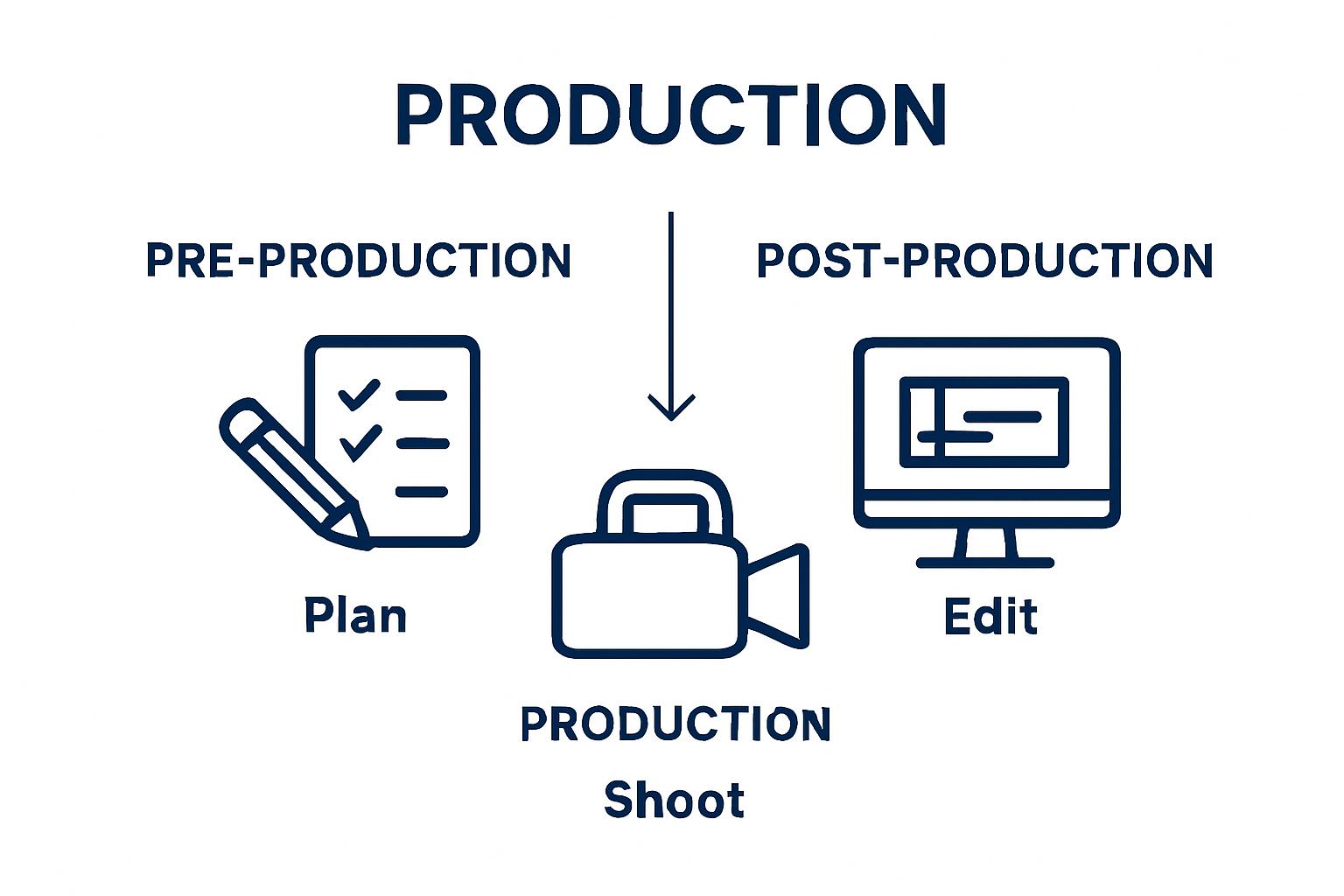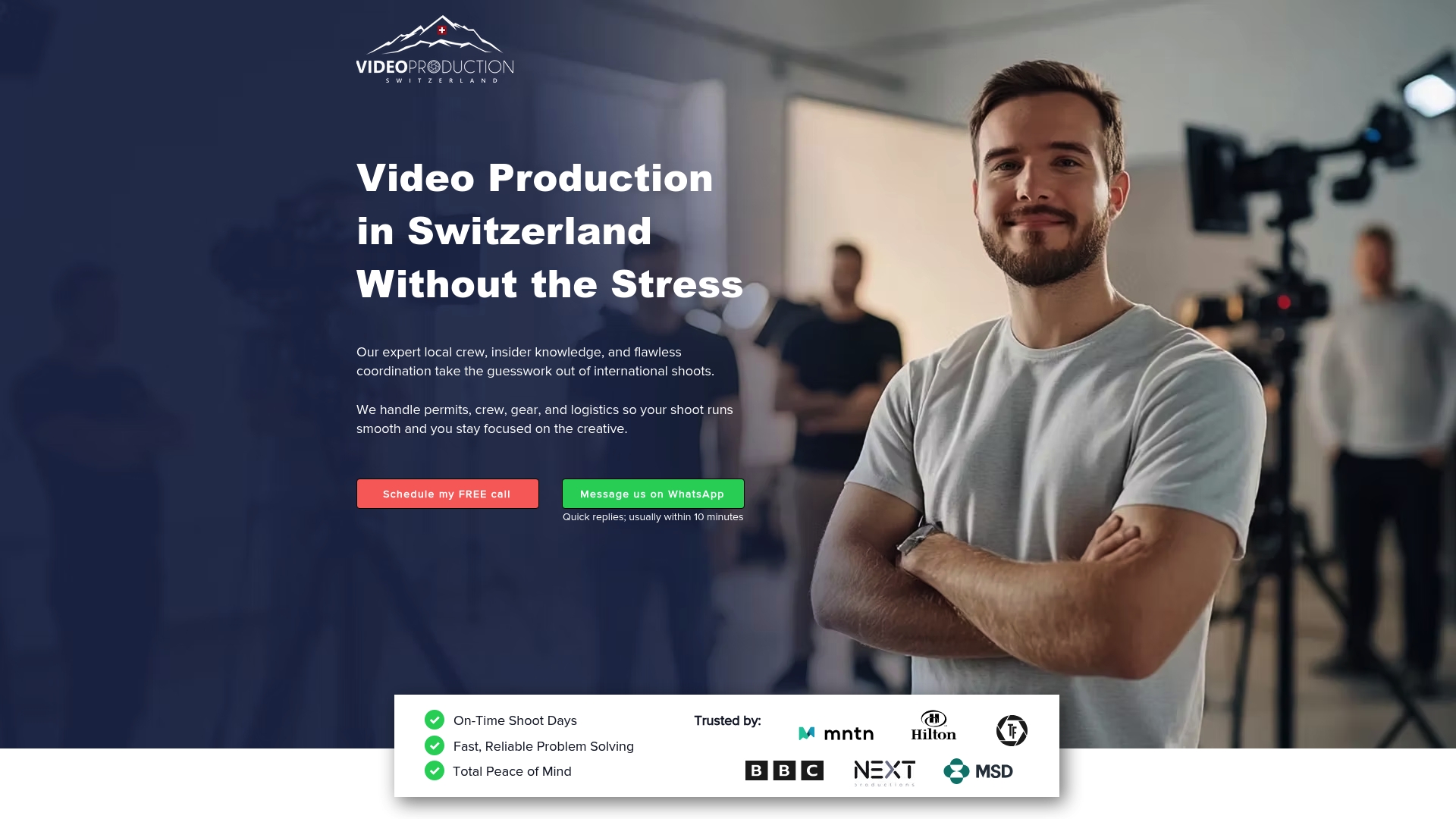Understanding the Corporate Video Production Process
- info1419758
- Sep 13
- 8 min read

Corporate video production shapes how companies tell their stories and connect with audiences in a crowded market. But surprise. Videos on company websites can increase the average time visitors spend by up to 88 percent compared to text. Most people think these videos are just fancy commercials. The real trick is that the right corporate video transforms dry business jargon into powerful visual stories that actually make people care.
Table of Contents
Quick Summary
Takeaway | Explanation |
Corporate videos enhance brand communication. | They provide a dynamic way to connect with audiences and convey complex messages effectively. |
Utilize various video formats for different goals. | Types include promotional, training, testimonial, and event recap videos, each serving distinct communication purposes. |
Strategic planning is crucial in video production. | Pre-production involves defining objectives and audience, which sets the foundation for successful video execution. |
Measure video success with specific metrics. | Focus on engagement and conversion metrics to assess the impact of corporate videos and inform future strategies. |
Collaboration is key in the production team. | Each team member plays a vital role, ensuring seamless execution of creative concepts into high-quality video content. |
What is Corporate Video Production?
Corporate video production is a strategic communication approach that involves creating professional visual content designed to support business objectives, brand messaging, and organizational storytelling. Unlike traditional entertainment or personal video projects, corporate videos serve specific professional purposes across multiple contexts.
The Core Purpose of Corporate Video Production
At its foundation, corporate video production transforms complex business narratives into engaging visual experiences. These videos act as powerful communication tools that can explain company services, showcase brand personality, train employees, document company events, or market products and services to targeted audiences. Our guide on video production best practices provides deeper insights into creating impactful corporate visual content.
According to AVIXA’s professional insights, corporate videos serve multiple critical functions:
Internal communication and employee training
External marketing and brand promotion
Investor and stakeholder presentations
Product demonstration and explanation
Corporate event documentation
Types of Corporate Video Content
Corporate video production encompasses diverse formats tailored to specific communication goals. These include:
Promotional Videos: Designed to highlight company products, services, or brand value proposition
Testimonial Videos: Featuring client or customer experiences to build trust and credibility
Training and Educational Videos: Providing structured learning experiences for employees or customers
Executive Communication Videos: Sharing leadership perspectives, company vision, or important announcements
Event Recap Videos: Documenting and preserving significant corporate moments
Successful corporate video production requires a strategic blend of creative storytelling, technical expertise, and clear communication objectives. Professional video producers work closely with organizations to translate complex business messages into compelling visual narratives that resonate with intended audiences.
To provide a clear overview of the different types of corporate video content and their main purposes, review the table below.
Video Type | Main Purpose |
Promotional Video | Highlight products, services, or brand value proposition |
Testimonial Video | Showcase client or customer experiences to build trust |
Training/Educational Video | Offer structured learning for employees or customers |
Executive Communication Video | Present leadership perspectives and important company messages |
Event Recap Video | Capture and preserve significant company events |
Importance of Corporate Videos in Branding
Corporate videos have transformed from optional marketing tools to essential components of modern brand communication strategies. They provide businesses with a dynamic and engaging method to connect with audiences, communicate complex messages, and establish a compelling brand narrative that resonates beyond traditional text-based communication.
Visual Storytelling and Brand Identity
Branding through video allows organizations to humanize their corporate identity and create emotional connections with audiences. These visual narratives go far beyond simple product demonstrations, offering viewers insights into company culture, values, and unique selling propositions. Our insights into future video marketing strategies highlight how video content can dramatically enhance brand perception.
According to University of Oregon’s brand communication research, corporate videos serve critical branding functions:
Communicate brand personality and core values
Create memorable visual representations of organizational culture
Differentiate the brand from competitors
Build trust through transparent storytelling
Engage audiences across multiple digital platforms
Strategic Benefits of Corporate Video Branding
Beyond aesthetic appeal, corporate videos deliver measurable strategic advantages. They enhance audience engagement, improve information retention, and provide versatile content that can be repurposed across various marketing channels. Professional video production transforms abstract corporate messages into compelling visual experiences that capture attention and drive meaningful audience interactions.
Key strategic benefits include:
Increased website visitor engagement and time spent on digital platforms
Higher conversion rates compared to text-based marketing materials
Enhanced search engine optimization through rich, shareable content
Improved social media reach and audience interaction
More effective communication of complex organizational narratives
By leveraging high-quality video content, brands can create powerful emotional connections, communicate their unique value proposition, and stand out in increasingly competitive digital landscapes.
Key Phases in the Corporate Video Production Process
Corporate video production is a complex, multifaceted process that requires strategic planning, creative execution, and technical expertise. Understanding the key phases helps organizations create compelling visual content that effectively communicates their message and achieves specific business objectives.

Pre-Production: Strategic Planning and Conceptualization
The pre-production phase is critical for laying the groundwork of a successful corporate video. During this stage, businesses collaborate with video production professionals to define project goals, target audience, key messaging, and overall creative direction. Our comprehensive guide on pre-production planning offers deeper insights into this foundational stage.
Essential elements of pre-production include:
Defining project objectives and key performance indicators
Developing a comprehensive creative brief
Identifying target audience and communication strategy
Scripting and storyboarding
Budget and resource allocation
Location scouting and talent selection
Production and Post-Production: Execution and Refinement
According to Johns Hopkins University’s professional video production insights, the production and post-production phases transform conceptual plans into polished visual narratives. The production phase involves actual video shooting, capturing raw footage according to the pre-planned script and creative vision.
Key components of production and post-production include:
Production Phase:
Professional equipment setup
Lighting and sound recording
Talent performance and direction
On-location video capture
Post-Production Phase:
Video editing and footage selection
Color grading and visual enhancement
Sound mixing and audio optimization
Adding graphics, animations, and transitions
Final review and client approval
Successful corporate video production requires a seamless integration of creative vision, technical skill, and strategic communication.
Below is a summary table outlining the main phases of corporate video production along with their primary activities for better process understanding.
Phase | Key Activities |
Pre-Production | Setting objectives, creative briefs, audience identification, scripting, budgeting |
Production | Equipment setup, filming, lighting, sound recording, directing talent |
Post-Production | Editing, color grading, sound mixing, adding graphics, final review |

By understanding and executing each phase with precision, organizations can create impactful video content that resonates with their target audience and supports their broader business objectives.
Roles and Responsibilities in Video Production
Corporate video production is a collaborative effort that requires a diverse team of professionals working synchronously to transform creative concepts into compelling visual narratives. Each team member plays a crucial role in ensuring the project’s successful execution, bringing specialized skills and expertise to different stages of production.
Core Production Team Roles
The foundation of any successful video production lies in understanding the distinct responsibilities of key team members. Our comprehensive guide explores the nuanced differences between directors and producers, providing deeper insights into their unique contributions.
According to U.S. Bureau of Labor Statistics professional guidelines, key production roles include:
Producer: Oversees the entire project, manages budgets, schedules, and coordinates between creative and logistical teams
Director: Develops creative vision, guides artistic execution, and manages talent performance
Cinematographer/Director of Photography: Responsible for visual composition, camera techniques, and lighting design
Production Manager: Handles logistical coordination, resource allocation, and on-set operational efficiency
Script Writer: Develops narrative structure, dialogue, and core messaging
Technical and Creative Specialists
Beyond core team roles, successful corporate video production involves a range of technical and creative specialists who contribute unique expertise. These professionals ensure the video meets high-quality standards and effectively communicates the intended message.
Technical and creative roles encompass:
Video Editors: Transform raw footage into cohesive, engaging narratives
Sound Engineers: Manage audio recording, mixing, and sound design
Graphic Designers: Create visual graphics, animations, and motion design elements
Colorists: Enhance visual aesthetics through color grading and correction
Accessibility Specialists: Ensure video content meets inclusive design standards
Effective corporate video production demands seamless collaboration, where each team member understands their role and works harmoniously towards creating a powerful visual communication tool that resonates with the target audience.
Measuring Success: Metrics in Corporate Video Impact
Measuring the effectiveness of corporate video content is crucial for understanding its strategic value and optimizing future communication efforts. Without robust metrics, organizations cannot accurately assess the return on their video production investments or understand how visual content influences audience behavior and business objectives.
Key Performance Indicators for Video Metrics
Corporate video success extends beyond traditional view counts, requiring a comprehensive approach to measuring impact. Our guide on video production project management provides additional insights into tracking performance metrics systematically.
According to Stanford’s Technology Ventures Program research, organizations should focus on multidimensional metrics that capture different aspects of video performance:
Engagement Metrics:
Total view count
Average watch time
Audience retention rate
Interaction rates (likes, shares, comments)
Click-through rates
Conversion Metrics:
Lead generation
Website traffic
Sales attributed to video content
Inquiries or consultation requests
Conversion rate from video viewers
Advanced Analytics and Strategic Insights
Modern video analytics provide deeper insights into audience behavior and content effectiveness. Sophisticated tracking tools enable organizations to understand not just how many people watched a video, but how they engaged with the content and what actions they took afterward.
Advanced measurement strategies include:
Demographic audience segmentation
Behavioral tracking across different platforms
Sentiment analysis of viewer interactions
Comparative performance benchmarking
Long-term brand perception shifts
By implementing comprehensive measurement strategies, organizations transform corporate videos from mere communication tools into strategic assets that drive measurable business outcomes and provide actionable insights for future content development.
Transform Your Corporate Video Vision into Reality with Local Expertise
Do you feel overwhelmed by the many phases of corporate video production, such as pre-production planning, crew management, and location logistics? Our article on understanding the corporate video production process highlights how critical seamless execution is for success. Many international brands and filmmakers encounter stress with permit requirements, sourcing reliable local teams, and securing high-quality equipment. Delays often arise from unfamiliarity with the Swiss environment or lack of direct access to trusted resources.

Let Video Production Switzerland remove the guesswork. We handle every aspect, from securing hard-to-get permits to assembling a professional local crew, so you can focus on creative storytelling. Start with a free consultation to discover how our experienced team can ensure your next shoot in Switzerland is timely, smooth, and truly stress-free. Need reassurance? Our client testimonials and transparent service process will show you why top brands trust us. Act now to secure your shoot and experience hassle-free production management tailored to your needs.
Frequently Asked Questions
What are the main phases of the corporate video production process?
The corporate video production process typically involves three main phases: pre-production (strategic planning and conceptualization), production (shooting the video), and post-production (editing and refinement).
How can corporate videos enhance brand identity?
Corporate videos enhance brand identity by humanizing the organization, creating emotional connections with audiences, and effectively communicating core values and brand personality through visual storytelling.
What types of corporate videos are commonly produced?
Common types of corporate videos include promotional videos, testimonial videos, training and educational videos, executive communication videos, and event recap videos, each serving specific communication purposes.
How can the success of a corporate video be measured?
The success of a corporate video can be measured through various key performance indicators (KPIs) such as engagement metrics (view counts, watch time), conversion metrics (lead generation, website traffic), and advanced analytics that track audience behavior and sentiment.
Recommended

Comments